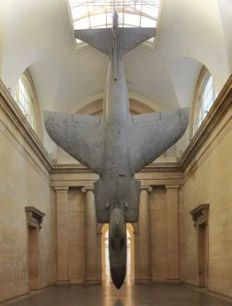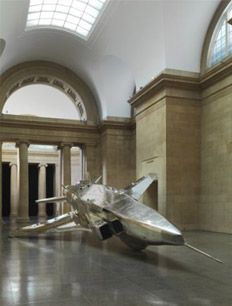Harrier and Jaguar: Unusual Rigging project at Tate Britain
18th November 2010
Many art installations are thought provoking, not least Harrier and Jaguar, the Duveens Commission 2010 installation by Fiona Banner at Tate Britain, which features two decommissioned fighter planes.
In the incongruous setting of the Duveen Galleries, a suspended Sea Harrier is transformed into a captive bird, the markings that tattoo its surface evoking its namesake the Harrier Hawk. A Jaguar lies belly up on the floor, its posture suggestive of a submissive animal. In placing these fighter planes in such close proximity to the viewer, Fiona explores the tension between the intellectual perception of the fighter plane and physical experience of the object. But there will also inevitably be visitors asking the question: ‘How did they get the planes in here?’
The planning for the rigging of the two aircraft began at the end of 2009. Unusual Rigging was asked to tender for the project following similar work at RAF Hendon and RAF Cosford although, says Robin Elias, Unusual’s project manager, “the two RAF projects were very different! For those projects, we had to keep restoration and conservation in mind, but in this case, we were free to gut the planes and, because of access problems, to ‘cut and shunt’ them.”
The location of the Duveen Galleries, on the second floor of Tate Britain, presented the first challenge: how to get the planes up there. There was only one answer – to cut the planes into smaller sections in such a way that they could be seamlessly reconstructed, inside the Gallery. Another consideration was the weight of the Harrier, which was too heavy to suspend from the existing steelwork in the roof of the Gallery. Fully loaded the Harrier weight 11,300kgs but Robin anticipated being able to get it down to 3,000kgs and designed the secondary steelwork accordingly.
Robin had the planes delivered to Unusual’s facility in Northamptonshire, where his team stripped out the planes to the barest minimum, while ensuring they retained their structural integrity. So all non essentials – hydraulics, electrics, navigation and radar equipment, undercarriage, etc – were removed under the supervision of Installation Engineer Chris Monahan, and the Harrier came down to a final weight of just 2,460kg. In the meantime, Unusual installed the additional weight bearing steelwork between the inner and outer glass skins of the Gallery roof.
When the planes had been stripped out, the next stage was to construct and fit internal steelwork so that, once cut into sections, they could be reassembled in position in the Gallery. For the Jaguar, strengthening steelwork was needed in the cockpit, port wing tip and tail fin, as these were the only points of contact with the floor, so needed to support the entire weight of the plane; the Harrier also required internal pick up points to which the internal rigging system could be fitted, culminating in just two rigging cables exiting the plane through the tail.
With each section on its own, custom-made dolly, the aircraft were delivered to Tate Britain, on London’s busy Millbank. Unusual were able to get their own lifting and rigging gear up to the Galleries in the goods lift, but the plane sections were just too large. A runway was constructed from pavement level to a first floor fire exit door, necessitating road closures for the load-ins, which were carried out at night to avoid impacting on other exhibits at the Tate.
To visitors, the Harrier seems suspended in time, the two cables carrying the plane all but invisible as they exit through its tail; close by, the Jaguar lies finely balanced upside down on the floor. This installation is indeed thought provoking, on many different levels.
Photo credit: Fiona Banner, Harrier and Jaguar, Tate Britain Duveens Commission 2010
Photography by Andrew Dunkley and Sam Drake ©TATE
Click for larger view



